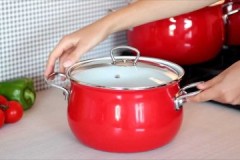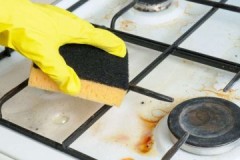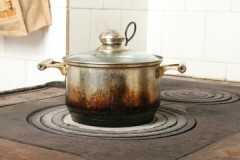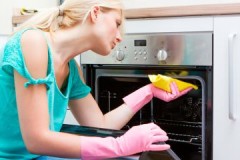 The main kitchen work surfaces are in constant contact with food and high temperatures. As a result, a carbon layer appears on them, which cannot be cleaned with ordinary detergents.
The main kitchen work surfaces are in constant contact with food and high temperatures. As a result, a carbon layer appears on them, which cannot be cleaned with ordinary detergents.
To cope with it and not damage kitchen utensils, they use improvised means and special chemicals. Read about how to quickly and safely remove carbon deposits in the article.
Content
Folk ways for home use
It is not necessary to acquire expensive or corrosive chemicals to get rid of the burning layer. You can use the tools at hand that can be found in the kitchen of every housewife.
Mode of application:
- Remove coarse debris from the surface. If some of the carbon deposits peel off even before the cleaning agent is applied, then it is swept away with a brush.
- Moisten the area that needs treatment with vinegar at a concentration of 9% or 6%. The most convenient way to apply it is with a spray.
- Soda is poured over the liquid.
- After 20 minutes after completion of the reaction, the surface is rinsed with clean water.
If necessary, the procedure is repeated again. This is most often required when the carbon layer is old and thick.
Another effective recipe is a soap and soda solution. Mode of application:
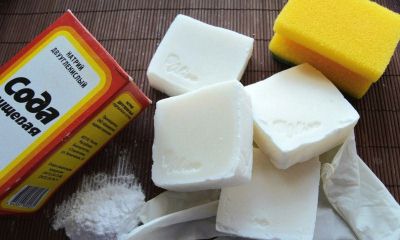 grind laundry soap;
grind laundry soap;- mix it in equal proportions with soda, add water - the result should be a creamy mass;
- the mixture is applied to the surface in need of cleaning, left for an hour - if it dries up, it is moistened with a spray bottle;
- clean the surface with a soft brush, rinse with clean water;
- This mild and effective carbon remover can be used several times in a row.
Regular table salt dissolves old soot well, but it will take time to get the result. Mode of application:
- 4 tablespoons of table salt are dissolved in two glasses of pure water. For it to disperse better, the water must be hot.
- Moisten the surface abundantly with saline. If possible, the product is completely immersed in it.
- Leave to soak overnight.
- In 12 hours, the carbon deposits will soften and can be easily cleaned off with a brush.
These recipes are versatile. They can be applied to any surface.
How to remove with special preparations?
There are commercially available formulations designed to remove carbon deposits from various products. You can purchase care products:
- behind the plates,
- dishes,
- grill and more.
The main thing is to use them for their intended purpose. Top 3 formulations for the fight against carbon deposits:
Forte plus sano
Active foam is easy to apply with a spray gun... The composition works quickly and efficiently due to the high concentration of cleaning agents. The product is suitable for the care of:
- microwave oven,
- kitchen stoves,
- grills,
- ovens.
Price - 600 rubles.
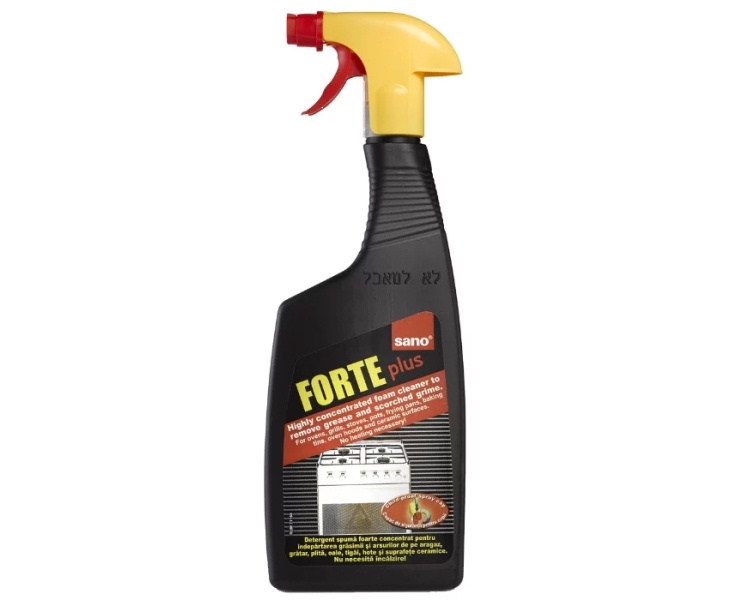
Stop-burn + Antinagar
Stove and grill cleaner can be used to remove burns from metal and enamel surfaces. It effectively handles even stubborn dirt... Price - 200 rubles.
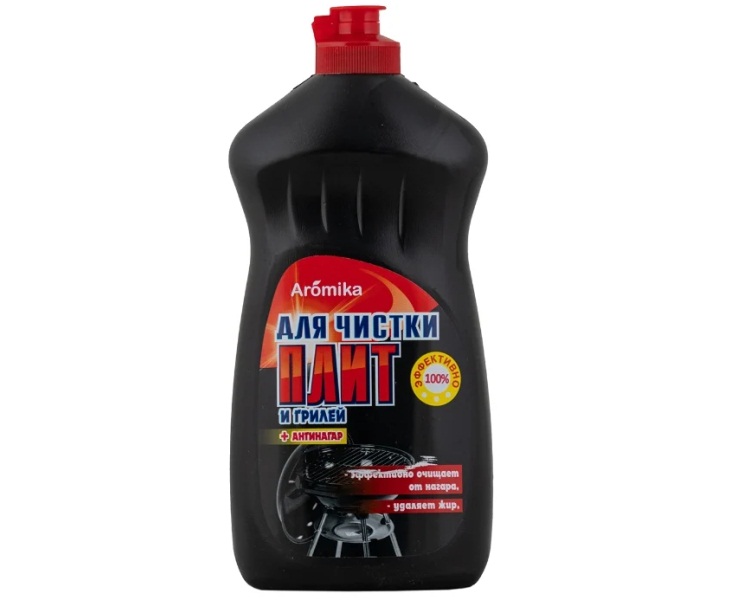
Kenolux Grill CID Lines
Concentrated liquid for dealing with carbon deposits and old grease. The composition is suitable for cooking stoves, ovens and grills. Price - 800 rubles.
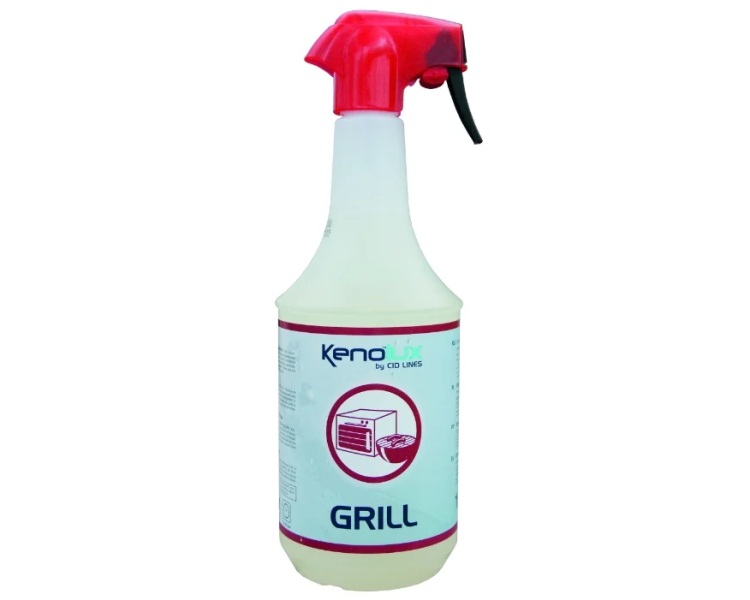
You need to choose a product that has a mark "from carbon deposits"... Broad-spectrum universal formulations may be ineffective.
How can various surfaces be cleaned?
Carbon deposits appear not only on dishes, but also on kitchen appliances. It can often be found on baking sheets, on various elements of gas and electric stoves, on a microwave and not only. Removal methods will differ depending on the type of surface.
Baking tray
There are several ways to remove carbon deposits from the baking sheet. The most effective remedies include:
- Coca-Cola or other carbonated water containing phosphoric acid. It is poured over the dishes and left for 3-6 hours. You can speed up the process by heating the liquid.
- Soda with hydrogen peroxide. First, the baking sheet is abundantly moistened with peroxide, after which it is sprinkled with soda and left for an hour.
- Soaking in a solution of laundry soap. To prepare it, you can use liquid soap, or grind the bar into shavings. In the solution, the baking sheet is soaked for 2-3 hours.
Gas and electric stove
You can clean the gas stove from carbon deposits with soda and dish detergent. The main thing is not to let liquid get on the burners.
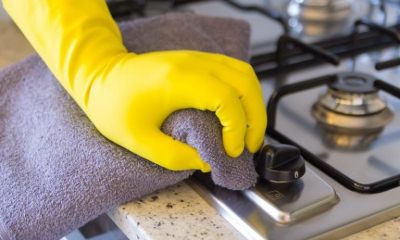 Procedure:
Procedure:
- moisten the surface with a soapy solution prepared on the basis of water and liquid dishwashing detergent;
- sprinkle the stove with soda;
- leave for 30-40 minutes;
- remove the softened soot with a sponge;
- wash with clean water, wipe dry with a cloth.
The carbon deposits are removed from the electric stove with an alcohol-based product. You can use glass cleaner. If it was not possible to cope with carbon deposits the first time, the liquid is left to act for 30-40 minutes, periodically moistening the surface. After washing, the stove is wiped dry.
For the maintenance of gas and electric stoves it is forbidden to use hard brushes or spongesas they will leave scratches behind.
Grates
You can remove carbon deposits from the grate of a gas stove using ammonia. It, in the amount of 2 tablespoons, is poured into a bag, into which a lattice is placed and left overnight. In the morning, all that remains is to rinse it with clean water and brush it off.
You can resort to heat treatment... To do this, the grate is heated in the oven and the soot is cleaned off with a metal brush. After such treatment, it remains only to rinse it with clean water and reinstall it. Will tell you more this article.
Oven
You can quickly get rid of carbon deposits in the oven with citric acid. Lemon in the amount of 10 g is diluted with warm water, which is poured into a baking sheet.The oven must be heated to 200 degrees, put the solution inside, close the lid and leave for 40 minutes. Then the gas is turned off, the baking sheet is removed, and the cooled oven is washed with any cleaning agent.
Read more here.
Dishes
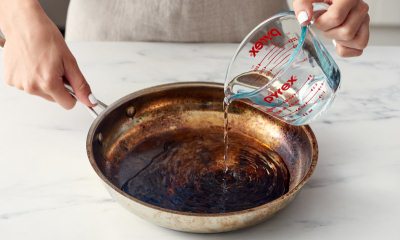 You can remove carbon deposits from dishes with soda and salt. They are used in the following way:
You can remove carbon deposits from dishes with soda and salt. They are used in the following way:
- Warm water is collected in the burnt dishes.
- Pour 1-2 tablespoons of soda and salt into it.
- They put the container on a gas stove, let the water boil.
- After half an hour, the liquid is drained, and the carbon deposits are removed with a brush.
You can also use acids: acetic or citric. They are used like soda and salt, but without heating. It is enough to withstand the acid in a burnt container for an hour. After which it must be washed in the usual way.
From the pan
You can clean a burnt pan with hydrogen peroxide and ammonia. Procedure:
- prepare a cleaning solution: for 1 liter of water, 50 ammonia and the same amount of peroxide are required;
- the liquid is boiled for half an hour, left to cool;
- drain the solution, clean the sides of the pan with a brush.
You can find out how to remove carbon deposits from a pan here, with enamel - here.
How to remove burnt in the microwave?
You can get rid of burning in a microwave using ordinary steam. Procedure:
- Pure water is poured into a deep bowl. You can add lemon zest to it for a pleasant aroma.
- Put the container in the microwave and turn it on at full power.
- Leave the water to boil for 10 minutes.
- Allow the appliance to cool down, remove the bowl and wash the walls with a damp soft cloth.
This method is effective against not only carbon deposits, but also fat deposits.
From the frying pan
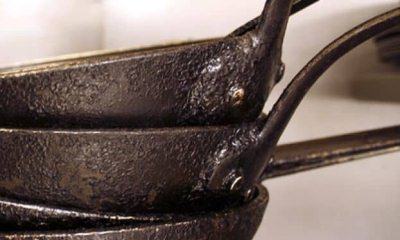 You can remove carbon deposits from the pan mechanically. For this, use ordinary sand..
You can remove carbon deposits from the pan mechanically. For this, use ordinary sand..
They are sprinkled on the surface of the product and rubbed with a brush. When the main layer of burning is removed, the dishes are washed using baking soda.
Cast iron pans lend themselves well to cleaning by calcining... The dishes are baked in the oven at a high temperature. Under the influence of heat, the soot will disappear on its own.
Read about cleaning the frying pan from carbon deposits. here, cast iron utensils - here.
What should you not do?
Prohibitions that must not be violated when removing burnt from various surfaces:
- Salting is not recommended for stainless steel products. They may darken.
- Acids and abrasives are not used to clean enamelled kitchen utensils.
- Cast iron products cannot be soaked in water for a long time so that they do not rust.
- Aluminum surfaces are not treated with soda and alkaline compounds.
- Teflon cookware does not tolerate contact with powders, hard brushes and sponges.
Helpful information
Tips to help remove carbon deposits from dishes and stoves:
- Clean your kitchen utensils right away. If you continue to cook on such surfaces, the carbon layer will become thicker and more difficult to cope with.
- After using any chemicals, the dishes need to be rinsed several times with clean water, or better yet, boiled.
- So that after removing carbon deposits from the dishes, you can boil a few coffee beans in it.
Conclusion
Removing carbon deposits from the stove, dishes and oven is easy if you choose the right product. You can cope with soot with the help of improvised tools and household chemicals. The main thing is to use formulations that are not capable of harming the product.
